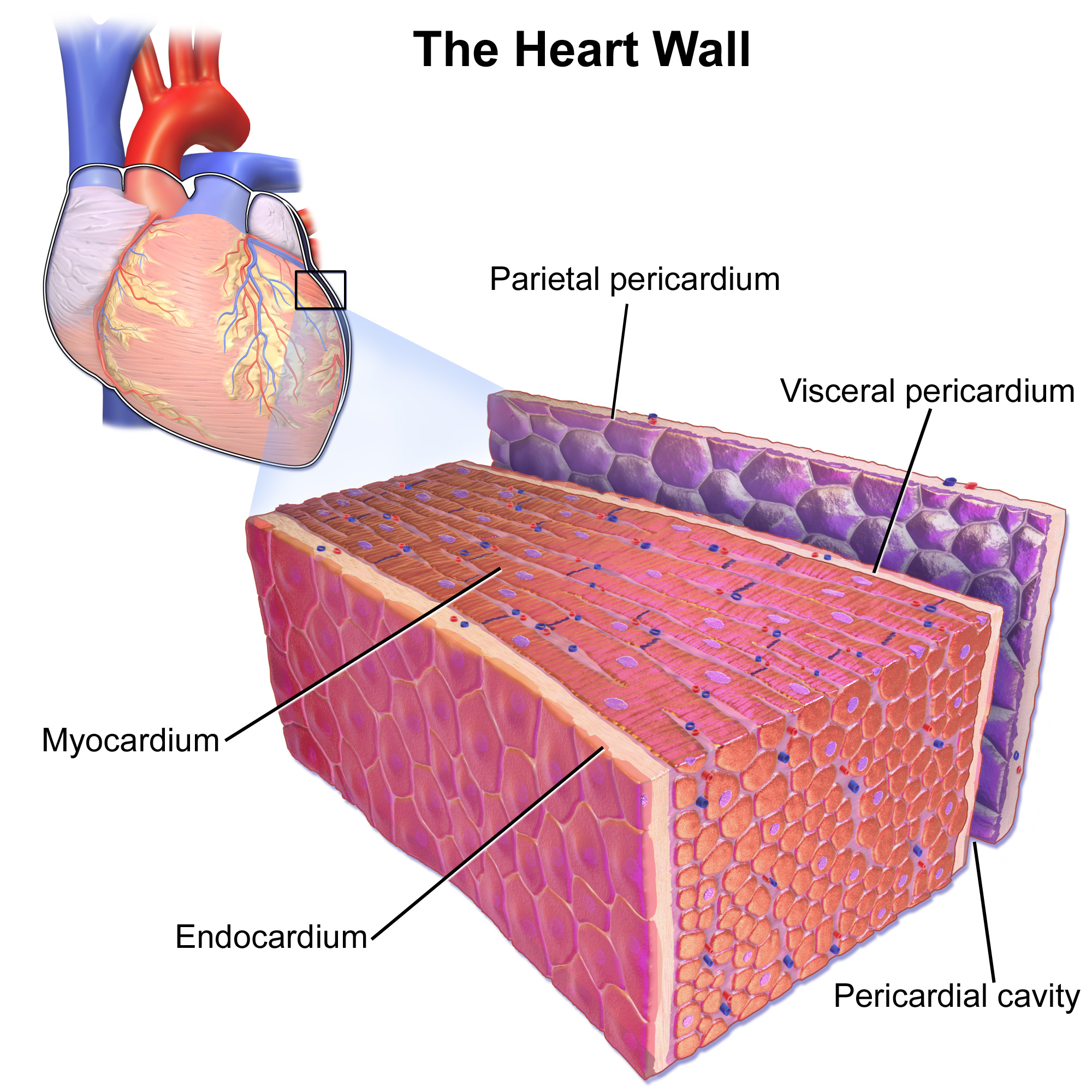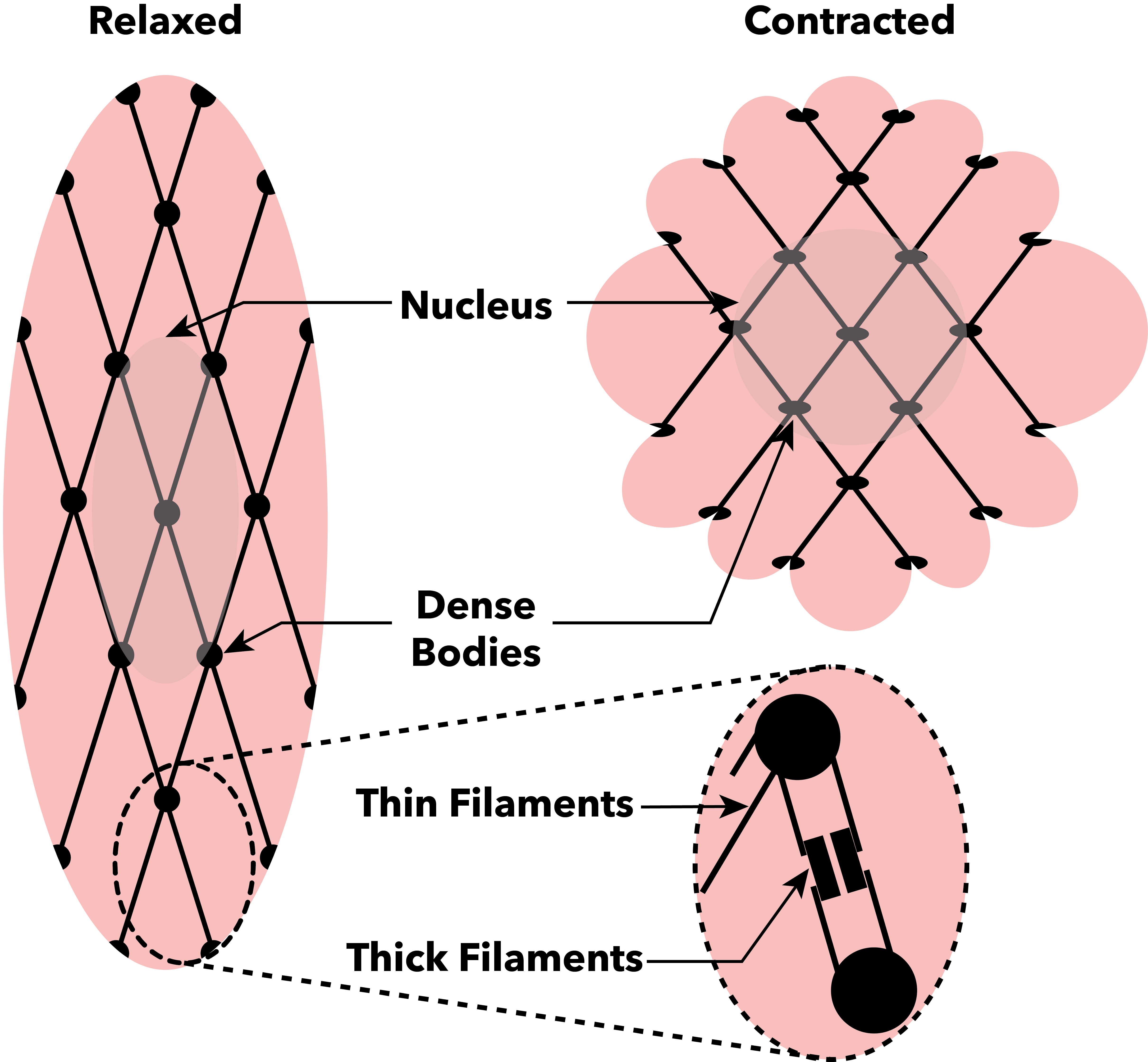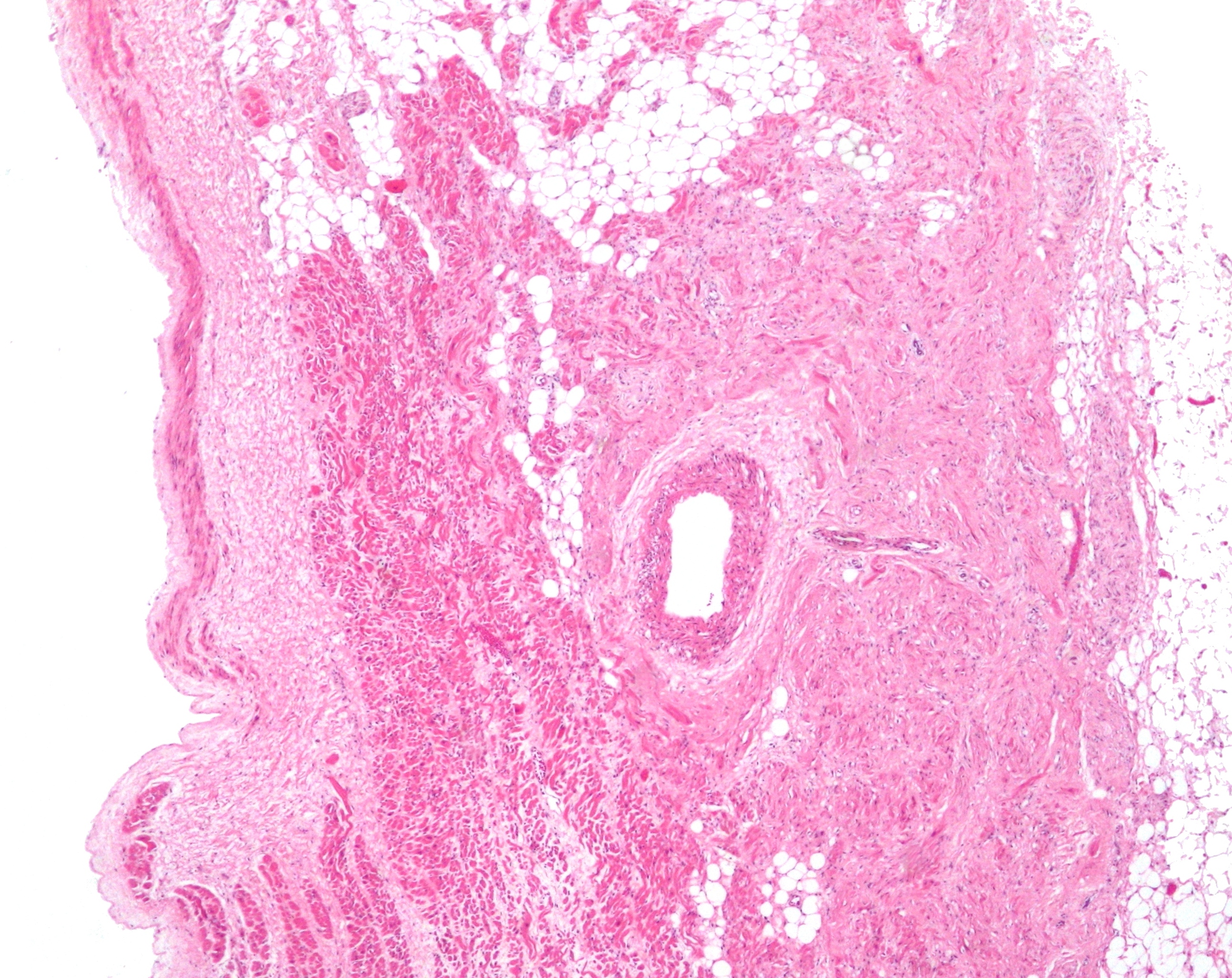|
Purkinje Fibers
The Purkinje fibers, named for Jan Evangelista Purkyně, ( ; ; Purkinje tissue or subendocardial branches) are located in the inner ventricular walls of the heart, just beneath the endocardium in a space called the subendocardium. The Purkinje fibers are specialized conducting fibers composed of electrically excitable cells. They are larger than cardiomyocytes with fewer myofibrils and many mitochondria. They conduct cardiac action potentials more quickly and efficiently than any of the other cells in the heart's electrical conduction system. Purkinje fibers allow the heart's conduction system to create synchronized contractions of its ventricles, and are essential for maintaining healthy and consistent heart rhythm. Histology Purkinje fibers are a unique cardiac end-organ. Further histologic examination reveals that these fibers are split in ventricles walls. The electrical origin of atrial Purkinje fibers arrives from the sinoatrial node. Given no aberrant channe ... [...More Info...] [...Related Items...] OR: [Wikipedia] [Google] [Baidu] |
QRS Complex
The QRS complex is the combination of three of the graphical deflections seen on a typical electrocardiogram (ECG or EKG). It is usually the central and most visually obvious part of the tracing. It corresponds to the depolarization of the right and left ventricles of the heart and contraction of the large ventricular muscles. In adults, the QRS complex normally lasts ; in children it may be shorter. The Q, R, and S waves occur in rapid succession, do not all appear in all leads, and reflect a single event and thus are usually considered together. A Q wave is any downward deflection immediately following the P wave. An R wave follows as an upward deflection, and the S wave is any downward deflection after the R wave. The T wave follows the S wave, and in some cases, an additional U wave follows the T wave. To measure the QRS interval start at the end of the PR interval (or beginning of the Q wave) to the end of the S wave. Normally this interval is 0.08 to 0.10 seconds. W ... [...More Info...] [...Related Items...] OR: [Wikipedia] [Google] [Baidu] |
Cardiac Skeleton
In cardiology, the cardiac skeleton, also known as the fibrous skeleton of the heart, is a high-density homogeneous structure of connective tissue that forms and anchors the valves of the heart, and influences the forces exerted by and through them. The cardiac skeleton separates and partitions the atria (the smaller, upper two chambers) from the ventricles (the larger, lower two chambers). The heart's cardiac skeleton comprises four dense connective tissue rings that encircle the mitral and tricuspid atrioventricular (AV) canals and extend to the origins of the pulmonary trunk and aorta. This provides crucial support and structure to the heart while also serving to electrically isolate the atria from the ventricles. The unique matrix of connective tissue within the cardiac skeleton isolates electrical influence within these defined chambers. In normal anatomy, there is only one conduit for electrical conduction from the upper chambers to the lower chambers, known as the atriov ... [...More Info...] [...Related Items...] OR: [Wikipedia] [Google] [Baidu] |
Force
In physics, a force is an influence that can cause an Physical object, object to change its velocity unless counterbalanced by other forces. In mechanics, force makes ideas like 'pushing' or 'pulling' mathematically precise. Because the Magnitude (mathematics), magnitude and Direction (geometry, geography), direction of a force are both important, force is a Euclidean vector, vector quantity. The SI unit of force is the newton (unit), newton (N), and force is often represented by the symbol . Force plays an important role in classical mechanics. The concept of force is central to all three of Newton's laws of motion. Types of forces often encountered in classical mechanics include Elasticity (physics), elastic, frictional, Normal force, contact or "normal" forces, and gravity, gravitational. The rotational version of force is torque, which produces angular acceleration, changes in the rotational speed of an object. In an extended body, each part applies forces on the adjacent pa ... [...More Info...] [...Related Items...] OR: [Wikipedia] [Google] [Baidu] |
Myocardium
Cardiac muscle (also called heart muscle or myocardium) is one of three types of vertebrate muscle tissues, the others being skeletal muscle and smooth muscle. It is an involuntary, striated muscle that constitutes the main tissue of the wall of the heart. The cardiac muscle (myocardium) forms a thick middle layer between the outer layer of the heart wall (the pericardium) and the inner layer (the endocardium), with blood supplied via the coronary circulation. It is composed of individual cardiac muscle cells joined by intercalated discs, and encased by collagen fibers and other substances that form the extracellular matrix. Cardiac muscle contracts in a similar manner to skeletal muscle, although with some important differences. Electrical stimulation in the form of a cardiac action potential triggers the release of calcium from the cell's internal calcium store, the sarcoplasmic reticulum. The rise in calcium causes the cell's myofilaments to slide past each other ... [...More Info...] [...Related Items...] OR: [Wikipedia] [Google] [Baidu] |
Bundle Branch
The bundle branches, or Tawara branches, transmit cardiac action potentials (electrical signals) from the bundle of His to Purkinje fibers in Ventricle (heart), heart ventricles. They are offshoots of the bundle of His and are important to the Cardiac conduction system, electrical conduction system of the heart. Structure There are two branches of the bundle of His: the left bundle branch and the right bundle branch, both of which are located along the interventricular septum. The left bundle branch further divides into the left anterior fascicle and the left posterior fascicle. These structures lead to a network of thin filaments known as Purkinje fibers. They play an integral role in the electrical conduction system of the heart by transmitting cardiac action potentials to the Purkinje fibers. Clinical significance When a bundle branch or their fascicles becomes injured (by underlying heart disease, myocardial infarction, or cardiac surgery), it may cease to conduct elect ... [...More Info...] [...Related Items...] OR: [Wikipedia] [Google] [Baidu] |
Cardiac Cycle
The cardiac cycle is the performance of the heart, human heart from the beginning of one heartbeat to the beginning of the next. It consists of two periods: one during which the heart muscle relaxes and refills with blood, called diastole, following a period of robust contraction and pumping of blood, called systole. After emptying, the heart relaxes and expands to receive another influx of blood returning from the lungs and other systems of the body, before again contracting. Assuming a healthy heart and a typical rate of 70 to 75 beats per minute, each cardiac cycle, or heartbeat, takes about 0.8 second to complete the cycle. Duration of the cardiac cycle is inversely proportional to the heart rate. Description There are two atrium (heart), atrial and two ventricle (heart), ventricle chambers of the heart; they are paired as the heart#Left heart, left heart and the heart#Right heart, right heart—that is, the left atrium with the left ventricle, the right atrium with the r ... [...More Info...] [...Related Items...] OR: [Wikipedia] [Google] [Baidu] |
Muscle Contraction
Muscle contraction is the activation of Tension (physics), tension-generating sites within muscle cells. In physiology, muscle contraction does not necessarily mean muscle shortening because muscle tension can be produced without changes in muscle length, such as when holding something heavy in the same position. The termination of muscle contraction is followed by muscle relaxation, which is a return of the muscle fibers to their low tension-generating state. For the contractions to happen, the muscle cells must rely on the change in action of two types of Myofilament, filaments: thin and thick filaments. The major constituent of thin filaments is a chain formed by helical coiling of two strands of actin, and thick filaments dominantly consist of chains of the Motor protein, motor-protein myosin. Together, these two filaments form myofibrils - the basic functional organelles in the skeletal muscle system. In vertebrates, Muscle cell#Muscle contraction in striated muscle, skele ... [...More Info...] [...Related Items...] OR: [Wikipedia] [Google] [Baidu] |
Electric Discharge
In electromagnetism, an electric discharge is the release and transmission of electricity in an applied electric field through a medium such as a gas (i.e., an outgoing flow of electric current through a non-metal medium).American Geophysical Union, National Research Council (U.S.). Geophysics Study Committee (1986) ''The earth's electrical environment''. National Academy Press, Washington, DC, p. 263. Applications The properties and effects of electric discharges are useful over a wide range of magnitudes. Tiny pulses of current are used to detect ionizing radiation in a Geiger–Müller tube. A low steady current can illustrate the gas spectrum in a gas-filled tube. A neon lamp is an example of a gas-discharge lamp, useful both for illumination and as a voltage regulator. A flashtube generates a short pulse of intense light useful for photography by sending a heavy current through a gas arc discharge. Corona discharges are used in photocopiers. Electric discharges can convey ... [...More Info...] [...Related Items...] OR: [Wikipedia] [Google] [Baidu] |
Pacemaker Potential
In the pacemaking cells of the heart (e.g., the sinoatrial node), the pacemaker potential (also called the pacemaker current) is the slow, positive increase in voltage across the cell's membrane, that occurs between the end of one action potential and the beginning of the next. It is responsible for the self-generated rhythmic firing (automaticity) of pacemaker cells. Background The cardiac pacemaker is the heart's natural rhythm generator. It employs pacemaker cells that generate electrical impulses, known as cardiac action potentials. These potentials cause the cardiac muscle to contract, and the rate of which these muscles contract determines the heart rate. As with any other cells, pacemaker cells have an electrical charge on their membranes. This electrical charge is called the membrane potential. After the firing of an action potential, the pacemaking cell's membrane repolarizes (decreases in voltage) to its resting potential of -60 mV. From here, the membrane gradual ... [...More Info...] [...Related Items...] OR: [Wikipedia] [Google] [Baidu] |
Sinoatrial Node
The sinoatrial node (also known as the sinuatrial node, SA node, sinus node or Keith–Flack node) is an ellipse, oval shaped region of special cardiac muscle in the upper back wall of the right atrium made up of Cell (biology), cells known as pacemaker cells. The sinus node is approximately 15 millimetre, mm long, 3 mm wide, and 1 mm thick, located directly below and to the side of the superior vena cava. These cells produce an Action potential, electrical impulse known as a cardiac action potential that travels through the electrical conduction system of the heart, causing it to muscle contraction, contract. In a healthy heart, the SA node continuously produces action potentials, setting the rhythm of the heart (sinus rhythm), and so is known as the heart's cardiac pacemaker, natural pacemaker. The rate of action potentials produced (and therefore the heart rate) is influenced by the nerves that supply it. Structure The sinoatrial node is an Ellipse, oval-shaped structure that ... [...More Info...] [...Related Items...] OR: [Wikipedia] [Google] [Baidu] |
Autonomic Nervous System
The autonomic nervous system (ANS), sometimes called the visceral nervous system and formerly the vegetative nervous system, is a division of the nervous system that operates viscera, internal organs, smooth muscle and glands. The autonomic nervous system is a control system that acts largely unconsciously and regulates bodily functions, such as the heart rate, its Myocardial contractility, force of contraction, digestion, respiratory rate, pupillary dilation, pupillary response, Micturition, urination, and Animal sexual behaviour, sexual arousal. The fight-or-flight response, also known as the acute stress response, is set into action by the autonomic nervous system. The autonomic nervous system is regulated by integrated reflexes through the brainstem to the spinal cord and organ (anatomy), organs. Autonomic functions include control of respiration, heart rate, cardiac regulation (the cardiac control center), vasomotor activity (the vasomotor center), and certain reflex, reflex ... [...More Info...] [...Related Items...] OR: [Wikipedia] [Google] [Baidu] |
Binucleated Cells
Binucleated cells are cells that contain two nuclei. This type of cell is most commonly found in cancer cells and may arise from a variety of causes. Binucleation can be easily visualized through staining and microscopy. In general, binucleation has negative effects on cell viability and subsequent mitosis. They also occur physiologically in hepatocytes, chondrocytes and in fungi (dikaryon). Causes * Cleavage furrow regression: Cells divide and almost complete division but then the cleavage furrow begins to regress and the cells merge. This is thought to be caused by nondisjunction in chromosomes but the mechanism by which it occurs is not well understood. * Failed cytokinesis: The cell can fail to form a cleavage furrow, leading to both nuclei remaining in one cell. * Multipolar spindles: Cells contain three or more centrioles, resulting in multiple poles. This leads to the cells pulling chromosomes in many directions that end in multiple nuclei found in one cell. * Mer ... [...More Info...] [...Related Items...] OR: [Wikipedia] [Google] [Baidu] |





